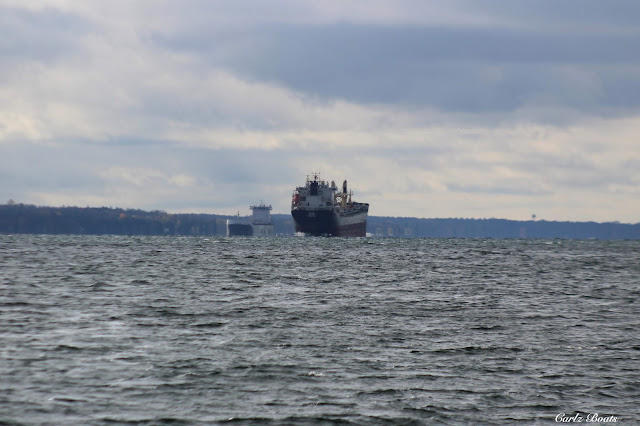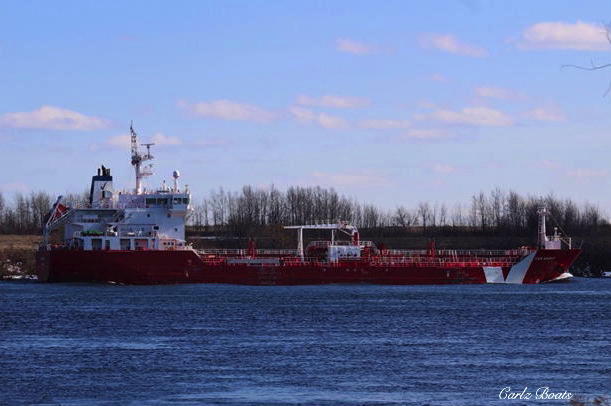No, it wasn't exactly a "Teddy Bear's Picnic" and though I shot many of my photos through branches and beneath trees, it wasn't the woods I was going to on Wednesday, October 28th, but the river, the St. Lawrence and my photo possibilities surely were a "big surprise".
With an inch of wet snow blanketing the neighbourhood, motoring anywhere
through that slop hadn't entered my mind for a second that day even though it was a day off and I truly didn't know when I'd be able to get back down to the river after my upcoming hernia surgery. That was until I saw photos taken by fellow boat watching friend, Pat English of the 740' CSL NIAGARA
unloading road salt at the Rideaubulk dock near Mariatown, a location I
had not been able to catch a ship at since by chance, I came across the
former Algoma Central self unloader PETER R. CRESSWELL discharging the hot commodity of the day then too, on October 8, 2012 (http://carlzboats.blogspot.com/2012/10/self-unloader-peter-r-cresswell.html).

Making that 90 minute drive to that wee dock on Lake St. Lawrence, a body of water that was created during the building of the Seaway was not going to happen but catching the Canada Steamship Lines self unloader underway along with the recently built Polsteam bulk carrier NARIE which was also upbound, was very doable regardless of the early-winter conditions. Actually I almost didn't make it to the river in time to even catch the 656' NARIE, I had barely parked at the foot of Centre Street in cute town of Prescott when the sitting high in ballast Polish-owned bulker effortlessly motored by.
Those unpredictable autumn skies along the river makes it look like the passage of the flagged Bahamas general cargo vessel took place late in the afternoon though it was just after lunch hour.
Even before I had time to check the whereabouts of the now upbound CSL NIAGARA, I suddenly noticed a downbound in the distance....
...loaded and bound for Port Cartier, the 740' ALGOMA STRONGFIELD was approaching the NARIE which was bound for Toledo...
...and soon realized that not only was I going to get an unexpected rendezvous but also a mid-river meet. Oh YAAA!!
From east of Prescott at Windmill Point, you can see the NARIE continuing to motor away towards Brockville in the distance, while another downbound, the cement carrier NACC ARGONAUT appears to the stern of the advancing ALGOMA STRONFIELD.
The Seaway-max size STRONGFIELD turns again to avoid another one of many shoals and shallow points along the seemingly vast upper St. Lawrence River.
After turns completed, shipping by the old windmill lighthouse runs very close to the Canadian side of the river.
While the NARIE had cranes topside to assist in unloading her cargoes, the oncoming ALGOMA STRONGFIELD has none requiring unloading to be done by dock equipment making her known as gearless bulk carrier.
One of my favourite vantage points, Battle of the Windmill National Historic Site.
Even though we're experiencing late summer temps today in the 20's celcius, it definitely looks like winter was near in this clouded over view from the end of Old Windmill Road.
The last of four Equinox-class gearless bulk carriers in Algoma Central's fleet renewal program, her original name was CWB STRONGFIELD when built in 2015 at Nantong Mingde Heavy Industry, in Nantong City, China...
...however before the then Canada Wheat Board owned vessel was completed, the shipbuilder went into bankruptcy. Algoma Central purchased the hull, had the construction completed and when she entered service in 2017 the vessel was renamed her ALGOMA STRONGFIELD .
As the STRONGFIELD, which is the name of a Canadian prairie wheat continues passed the Port Of Johnstown's riverfront docks the upbound CSL NIAGARA approaches beyond the Ogdensburg-Prescott International Bridge.
Trying to get a better view of my next ship-meet, I was able to find some high ground above the port's dock, but then had to contend with shooting through swaying branches in wind gusts of 28km and dead ones from a partially submerged tree along the shoreline. Meanwhile you can see the two 740's position themselves to complete their meet beneath the 1.5 mile suspension bridge in this sequence of photos...
....ALGOMA STRONGFIELD starts to turn to starboard as the rounded bow of CSL NIAGARA makes a wide wake as she pushes against the steady river current...
...while CSL NIAGARA maintains her course, ALGOMA STRONGFIELD continues to swing right...
...while the gap between the two passing ships widens below, an 18 wheeler crosses over to the Canadian side on the completed in 1969 suspension bridge that remains closed to non essential travel due to the pandemic.
With the STRONGFIELD out of her way, the NIAGARA straightens out as she approaches the Port of Johnstown...
She was known as J.W. McGIFFIN when christened by her namesake, the then CSL chairman of the board at Collingwood Shipyards on April 11, 1972. At 730' in length and 75' wide, the 34,380 ton cargo capacity McGIFFIN was the first in a new class of domestic self unloading bulk carriers with a rounded bow, flat stern, and all cabins and wheelhouse aft.
When seaway-maximum sizes were revised, she was also the first in her class to receive a new and larger forebody at Port Weller Dry Dock. Renamed CSL NIAGARA, she re-entered service in 1999, 10' longer, 3' wider and deepened by 1.5' which increased her cargo capacity to just under 38,000 tons.
While built primary to haul coal from Lake Erie ports of Conneault and Toledo to steel mills in Hamilton, Nanticoke and Sault Ste, Marie and the Ontario Hydro coal burning plants at Courtright, Nanticoke and Port Credit., these days her cargoes also includes iron ore, salt, grain and stone.
As
CSL NIAGARA continues her upbound passage to Toledo, another meet was about to begin, with the cement carrier
NACC ARGONAUT skirting the American side of the river while bound for Trois-Rivieres.
While the sleek and bulbous of the NACC ARGONAUT appears, tossed wave spray and furiously flapping flags make for an interesting effect as the big CSL NIAGARA pushes on into the strong and constant wind gusts that day in these next two photos.
Her name was ARKLOW WAVE when built at Kyokuyo Shipyard, in Shimonoseki, Japan in 2003. She was a general cargo vessel then like fleetmate ARKLOW WILLOW which is now named FLORENCE SPIRIT.
She was converted into a cement carrier in 2017 and initially named NACC TORONTO, but changed to NACC ARGONAUT before taking over the cement trade for Lafarge on the lower Great Lakes and St. Lawrence River in 2018.
NovaAlgoma Cement Carriers (NACC) was founded in 2016 as a 50/50 joint venture company between Algoma Central Corporation and Nova Marine Holdings SA of Luxemborg dedicated to building a global fleet of cement Carriers to support infrastructure projects worldwide.
The 447.5' NACC ARGONAUT is just over 40' longer than her predecessor, ENGLISH RIVER seen entering Toronto harbour on August 27, 2011 in the background of this all of my Carlz Boats blogposts. At 14, 650 tonnes, she can also carry almost double the cement capacity of the former CSL package goods freighter which is still being dismantled in Port Colborne.
Well I certainly got more than I bargained for during this last rendezvous at the river. While today at home "relaxing" with another cold pack on my groin to sooth the pain from my hernia surgery last week, you might say it's exactly what the doctor ordered. Anyhow my recovery is one day at a time and hopefully before I know it I'll out and about photographing boats. The sooner the better.



















































